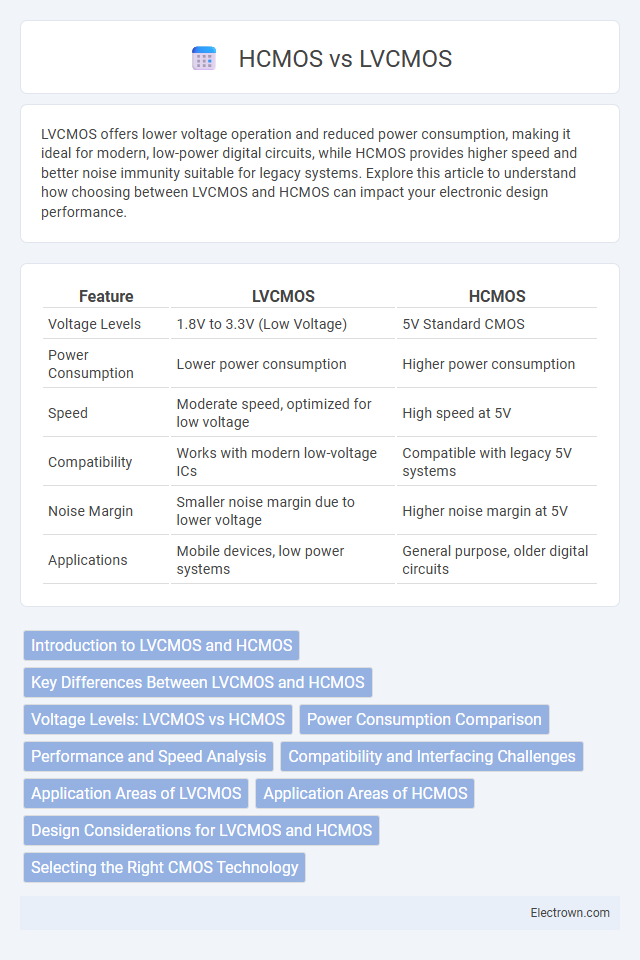LVCMOS offers lower voltage operation and reduced power consumption, making it ideal for modern, low-power digital circuits, while HCMOS provides higher speed and better noise immunity suitable for legacy systems. Explore this article to understand how choosing between LVCMOS and HCMOS can impact your electronic design performance.
Table of Comparison
| Feature | LVCMOS | HCMOS |
|---|---|---|
| Voltage Levels | 1.8V to 3.3V (Low Voltage) | 5V Standard CMOS |
| Power Consumption | Lower power consumption | Higher power consumption |
| Speed | Moderate speed, optimized for low voltage | High speed at 5V |
| Compatibility | Works with modern low-voltage ICs | Compatible with legacy 5V systems |
| Noise Margin | Smaller noise margin due to lower voltage | Higher noise margin at 5V |
| Applications | Mobile devices, low power systems | General purpose, older digital circuits |
Introduction to LVCMOS and HCMOS
LVCMOS (Low Voltage Complementary Metal-Oxide-Semiconductor) operates at lower voltage levels, typically 1.8V to 3.3V, offering reduced power consumption and better noise immunity compared to traditional CMOS. HCMOS (High-Speed CMOS) is designed for higher speed performance with voltage levels usually between 4.5V and 5.5V, making it suitable for applications requiring faster switching speeds. Both technologies are used in digital logic circuits, with LVCMOS favored for low-power devices and HCMOS preferred in high-speed timing-sensitive applications.
Key Differences Between LVCMOS and HCMOS
LVCMOS (Low-Voltage CMOS) operates at lower voltage levels, typically 1.8V to 3.3V, offering reduced power consumption and enhanced noise immunity compared to traditional HCMOS, which usually runs at 5V. HCMOS (High-speed CMOS) provides faster switching speeds but at the cost of higher power dissipation and voltage levels that may not be compatible with modern low-voltage systems. Your choice between LVCMOS and HCMOS depends on the required voltage compatibility, power efficiency, and speed for your digital circuit applications.
Voltage Levels: LVCMOS vs HCMOS
LVCMOS (Low-Voltage CMOS) operates at lower voltage levels, typically around 1.2V to 3.3V, offering reduced power consumption and improved noise margins for modern digital circuits. HCMOS (High-Speed CMOS) typically functions at higher voltages, such as 5V, enabling faster switching speeds but with increased power dissipation. Your choice between LVCMOS and HCMOS voltage levels depends on the power efficiency and speed requirements of your application.
Power Consumption Comparison
LVCMOS technology offers significantly lower power consumption compared to HCMOS, making it ideal for battery-powered and low-power applications. LVCMOS operates at lower voltage levels, typically around 3.3V or below, reducing dynamic power dissipation considerably in your digital circuits. Choosing LVCMOS can extend device battery life and decrease heat generation, crucial for energy-efficient designs.
Performance and Speed Analysis
LVCMOS (Low Voltage Complementary Metal-Oxide-Semiconductor) operates at lower voltage levels, typically 1.2 to 3.3 volts, enabling reduced power consumption and faster switching speeds compared to standard HCMOS (High-Speed CMOS) which generally functions at 5 volts. The reduced voltage swing in LVCMOS decreases delay times and enhances signal integrity, making it ideal for high-frequency digital circuits. HCMOS offers robust noise margins but often experiences slower transition speeds and higher power dissipation due to its higher operating voltage.
Compatibility and Interfacing Challenges
LVCMOS (Low-Voltage CMOS) and HCMOS (High-Speed CMOS) differ significantly in voltage levels, which can cause compatibility and interfacing challenges when mixed in a design. LVCMOS typically operates at 1.8V to 3.3V, while HCMOS often uses 4.5V to 5.5V, requiring level shifters or voltage translators to ensure signal integrity and prevent damage. Your system's performance and reliability depend on proper interfacing techniques that accommodate these voltage mismatches.
Application Areas of LVCMOS
LVCMOS is widely used in applications requiring low power consumption and high-speed digital logic circuits, such as portable devices, microcontrollers, and FPGA interfacing. It is ideal for battery-powered systems where energy efficiency is critical, including smartphones, wearable technology, and IoT devices. LVCMOS also supports modern communication interfaces and memory modules, making it a preferred choice for system-on-chip (SoC) and embedded system designs.
Application Areas of HCMOS
HCMOS technology is widely used in microcontrollers, digital integrated circuits, and communication devices due to its high speed and low power consumption compared to traditional CMOS. It is favored in applications requiring fast switching speeds, such as clock generators, phase-locked loops, and RF circuits. Its robustness and noise immunity make it suitable for automotive electronics, consumer gadgets, and industrial control systems.
Design Considerations for LVCMOS and HCMOS
Design considerations for LVCMOS focus on low voltage operation, offering reduced power consumption and compatibility with modern low-voltage digital circuits, making it ideal for battery-powered and high-density applications. HCMOS design emphasizes high-speed performance and stronger noise immunity, suited for systems requiring faster switching and higher drive capability. Your choice depends on the trade-off between power efficiency and speed requirements in the specific electronic design.
Selecting the Right CMOS Technology
Selecting the right CMOS technology depends on your application's speed, power consumption, and noise immunity requirements. LVCMOS (Low-Voltage CMOS) offers lower power consumption and is ideal for modern low-voltage digital circuits, while HCMOS (High-Speed CMOS) provides faster switching speeds suitable for high-frequency applications. Balancing these factors ensures optimal performance and reliability in your electronic designs.
LVCMOS vs HCMOS Infographic

 electrown.com
electrown.com